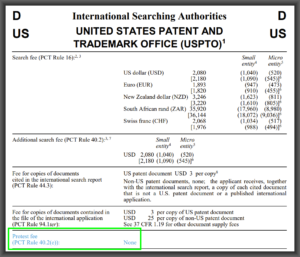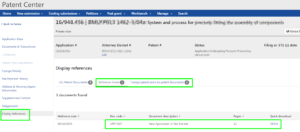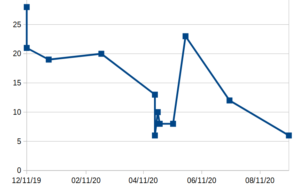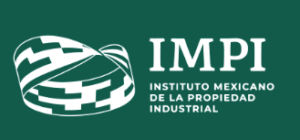
Here is an example of a patent office being remarkably responsive to a user concern.
Continue reading “An example of Patent Office responsiveness”

Bluesky: @oppedahl.com

Here is an example of a patent office being remarkably responsive to a user concern.
Continue reading “An example of Patent Office responsiveness”

Yet another oddity in USPTO’s handling of a DOCX patent application file … this DOCX file is now displayed in “Display References”. Not only that, it is displayed in two different places in “Display References”. Continue reading “What happens if you file using a DOCX file”
When the USPTO made Patentcenter available for alpha testing about two years ago, I was one of the alpha testers. As an alpha tester, I reported bug after bug to the USPTO. But I did not criticize the USPTO publicly. I was a good alpha tester, reporting the bugs only privately to the USPTO.
This went on for a year, and then USPTO quietly shifted from alpha testing to beta testing, and it meant that more users got added to the pool of testers. The beta testing was also a closed environment, just like the alpha testing. I was a good beta tester, continuing to report bugs only privately to the USPTO.
I think it is possible that my firm was the most diligent and prolific alpha- and beta-tester of Patentcenter during the closed alpha and closed beta testing phases. What makes me think this is:
To the USPTO’s credit, it did fix perhaps one-third of the bugs that alpha- and beta-testers reported. But even now, two years later, many bugs that alpha- and beta-testers have reported to the USPTO have not gotten fixed.
This would not be so bad except that a few months ago the USPTO decided to release Patentcenter for beta testing by the general public. Anybody who wishes may now make use of Patentcenter.
And so as of that time I felt there is no need to keep bug reports private. I set up the Patentcenter listserv, which is an email discussion group for beta testers of Patentcenter. I set up the Patentcenter trouble ticket web site.
What is disappointing is that many Patentcenter bugs that have been reported to the USPTO since it released Patentcenter for beta testing by the public have not been fixed. What is even more disappointing is that many Patentcenter bugs reported a year ago or even two years ago by beta- and alpha-testers have not been fixed.
Here is one example among dozens.
When you upload a PDF as part of your e-filing activity, your natural expectation about it might be:
If you upload it, and if you preview it in the e-filing system, and if it looks the way it is supposed to look, then you can safely click “submit” and it will look that way in IFW.
In ePCT, this is indeed how it works. If it is going to get degraded when you click “submit”, then the preview will show you what the degraded file would look like. This gives you fair warning. You can then set to work trying to figure out what to do differently so that the file will not get degraded so badly.
In Patentcenter, this is not how it works. A file containing gray scale might look perfectly normal to the human eye when previewed in Patentcenter. But it will get degraded badly after you click “submit”, and it might get degraded to the point of being unreadable.
Not only that, Patentcenter might convert it into blank pages.
I am not making this up. Blank pages. The preview will show normal pages that are not blank. And when you click “submit”, what will later turn up in IFW might be blank pages.
One thing that this means is that to protect yourself from malpractice liability when using Patentcenter, you have no choice but to go into IFW after you have e-filed a document, to view it and to see whether it has gotten converted into blank pages. And to see whether it has gotten blurred or degraded, perhaps to the point of unreadability.
This is not easy to do if, as has very often happened in recent weeks, you cannot see it at all in IFW until a day or two after the day that you e-filed it.
Which brings me to my disappointment at USPTO’s failure to attend to bugs that are being reported these days by the listserv community. Take a look at bug number CP27 . This bug is the problem of Patentcenter converting a perfectly readable PDF file into blank pages. This bug got reported to the USPTO on June 8, 2020. I blogged about it on June 8, 2020. Three weeks passed with no corrective action by the USPTO, so one of the listserv volunteers (Richard Schafer) cross-posted the bug report into Ideascale (direct link) on July 4, 2020. Nobody from USPTO has responded in any way to this posting in Ideascale.
What prompted this blog posting today is a disappointing thing that happened yesterday when I e-filed a new patent application in Patentcenter. This time I got lucky and I was able to see the newly filed application in IFW right away instead of having to wait several days for it to be visible in IFW. And I was astonished to see that the USPTO had still not corrected the defect in Patentcenter that Patentcenter sometimes converts a PDF into blank pages.
Months have passed since this extremely serious bug got reported to the USPTO, and it has not been attended to even now.
As I say, in this case I got lucky. Instead of having to wait several days for the newly filed application to be visible in IFW, I was able to see this application right away in IFW. I clicked through the 120 or so pages of what I just e-filed, to see what damage Patentcenter had done to the various files that I had uploaded. Yes, many files were degraded but most of the degradations were modest enough to permit the pages to continue to be human readable. But three pages had gotten converted to blank pages. I then located the source PDF document and printed it to CutePDF and uploaded it and e-filed it again. This time Patentcenter did not convert it to blank pages. Because I was able to deal with this malfunction in Patentcenter on the same day that Patentcenter malfunctioned, I did not need to worry about losing a filing date due to the malfunction in Patentcenter.
But what is so very disappointing is that USPTO has seemingly paid no attention to this extremely serious bug report, even after some three months.
The time is 5AM Mountain Time on a Saturday. I post a new blog article How long it takes USPTO to issue a patent these days. Is anyone else awake at this hour? The answer to this question turns out to be “yes”. I know this because my blog has a “Site Stats” page that tells me how many times a blog article has been viewed. And what I see there is that within two minutes of when I clicked the “publish” button, more than twenty people had already viewed the article.
So I think it can safely be said that the hive mind never sleeps.

I am gobsmacked to see how consistently quickly USPTO is issuing patents these days. Design patents are taking less than five weeks. Utility patents are taking less than six weeks. Continue reading “How long it takes USPTO to issue a patent these days”
 In the PCT listserv, a practitioner recently exasperatedly asked:
In the PCT listserv, a practitioner recently exasperatedly asked:
What is the protest fee in the International Searching Authority at the USPTO?
The movie Airplane makes clear how such a question should be answered.
Rumack (Leslie Nielson): You’d better tell the Captain we’ve got to land as soon as we can. This woman has to be gotten to a hospital.
Elaine Dickinson (Julie Hagerty): A hospital? What is it?
Rumack: It’s a big building with patients, but that’s not important right now.
So we realize the answer is:
It’s a fee that you pay if you have been invited to pay additional search fees and if you wish to protest the finding of a lack of unity of invention. But that’s not important right now.
Later in the same movie the following exchange occurs:
Elaine Dickinson: You got a letter from headquarters this morning.
Ted Striker: What is it?
Elaine Dickinson: It’s a big building where generals meet, but that’s not important.
Note the particular cleverness that Elaine delivers the straight line in the first exchange, and having learned how to be funny about this, in the second exchange she is the one to deliver the punch line.
Of course there is always the chance, however remote, that the practitioner was really asking something like:
What is the amount of the protest fee in ISA/US?
This turns out to be a very interesting question, and it prompted me to look up and compare the protest fees in each of the twenty-three ISAs. Here is the answer. Continue reading “What is the protest fee in ISA/US?”
Just now I wrote to David Gooder, the Commissioner for Trademarks, asking him to please pass along thanks to some of his people. Here is part of what I wrote to him today, edited slightly for blog style. The main point is that today, the Trademark Office was nice to its customers and to the listserv community. Continue reading “The Trademark Office being nice to its customers”
 Yet another intellectual property office has joined DAS. The Mexican Institute of Industrial Property (IMPI) will become a Depositing Office and an Accessing Office in DAS on Tuesday, November 3, 2020.
Yet another intellectual property office has joined DAS. The Mexican Institute of Industrial Property (IMPI) will become a Depositing Office and an Accessing Office in DAS on Tuesday, November 3, 2020.
Only just now did I notice that the logo for IMPI is a Möbius strip!
IMPI will be a Depositing Office for:
In addition, RO/MX will be a Depositing Office for purposes of PCT applications filed in RO/MX.
This offers a reminder that Mexico is one of the seventy-six Offices that provides utility model protection.
IMPI will be an Accessing Office for:
Which intellectual property firm in Mexico is the most trendy, modern, and up-to-date? Send me a DAS access code for a Mexican patent application, a DAS access code for a Mexican utility model application, a DAS access code for a Mexican industrial design application, and a DAS access code for a PCT application filed in RO/MX. I can then post Certificates of Availability (with a few digits of the application numbers blurred) for those four applications, and I will then be able to recognize your firm as the most trendy, modern and up-to-date intellectual property firm in Mexico.

It is recalled (see blog post “Captain May I?” in Hague Agreement applications, August 20, 2020 and open letter to the Commissioner for Patents, September 2, 2020) that in about June of 2020 the USPTO came up with the notion that there was a trap for the unwary in the use of DAS as a way to perfect a priority claim in a US designation from a Hague Agreement design application. The USPTO decided that I had supposedly stepped into this trap twice, representing a design applicant in two 35-series design patent applications.
Now the USPTO seems to have walked it back. Although the USPTO did not communicate the walk-back as clearly as one might wish, the USPTO seems to have decided that this trap for the unwary never actually existed. It means I never stepped into the trap, given that it never actually existed. Continue reading “USPTO seems to have walked back the US-designation-Hague-DAS-certified-copy problem”
This blog post describes some most recent developments in the business of the Trademark Office granting $100 petitions for trademark applicants who do not want to tell Trademark Office employees exactly where they sleep at night. This blog post talks about the privacy situation where the named applicant is a legal person (such as an LLC) rather than a natural person (a human being). Continue reading “The price of trademark privacy continues to be $100”